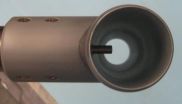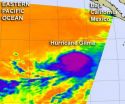(Press-News.org) CAMBRIDGE, MA -- Earthworms creep along the ground by alternately squeezing and stretching muscles along the length of their bodies, inching forward with each wave of contractions. Snails and sea cucumbers also use this mechanism, called peristalsis, to get around, and our own gastrointestinal tracts operate by a similar action, squeezing muscles along the esophagus to push food to the stomach.
Now researchers at MIT, Harvard University and Seoul National University have engineered a soft autonomous robot that moves via peristalsis, crawling across surfaces by contracting segments of its body, much like an earthworm. The robot, made almost entirely of soft materials, is remarkably resilient: Even when stepped upon or bludgeoned with a hammer, the robot is able to inch away, unscathed.
Sangbae Kim, the Esther and Harold E. Edgerton Assistant Professor of Mechanical Engineering at MIT, says such a soft robot may be useful for navigating rough terrain or squeezing through tight spaces.
The robot is named "Meshworm" for the flexible, meshlike tube that makes up its body. Researchers created "artificial muscle" from wire made of nickel and titanium — a shape-memory alloy that stretches and contracts with heat. They wound the wire around the tube, creating segments along its length, much like the segments of an earthworm. They then applied a small current to the segments of wire, squeezing the mesh tube and propelling the robot forward. The team recently published details of the design in the journal IEEE/ASME Transactions on Mechatronics.
In addition to Kim, the paper's authors are graduate student Sangok Seok and postdoc Cagdas Denizel Onal at MIT, associate professor Robert J. Wood at Harvard, assistant professor Kyu-Jin Cho PhD '07 of Seoul National University, and Daniela Rus, professor of computer science and engineering and director of MIT's Computer Science and Artificial Intelligence Laboratory (CSAIL).
Soft-serve robotics
In the past few decades, many roboticists have looked for ways to engineer soft robotic systems. Without bulky, breakable hardware, soft robots might be able to explore hard-to-reach spaces and traverse bumpy terrain. Their pliable exteriors also make them safe for human interaction.
A significant challenge in soft robotics has been in designing soft actuators, or motors, to power such robots. One solution has been to use compressed air, carefully pumped through a robot to move it. But Kim says air-powered, or pneumatic, robots require bulky pumps. "Integrating micro air compressors into a small autonomous robot is a challenge," Kim says.
Artificial muscle from a bizarre material
Instead, Kim and his colleagues looked to the earthworm for design guidance. They noted that the creepy crawler is made up of two main muscle groups: circular muscle fibers that wrap around the worm's tubelike body, and longitudinal muscle fibers that run along its length. Both muscle groups work together to inch the worm along.
The team set out to design a similar soft, peristalsis-driven system. The researchers first made a long, tubular body by rolling up and heat-sealing a sheet of polymer mesh. The mesh, made from interlacing polymer fibers, allows the tube to stretch and contract, similar to a spring.
They then looked for ways to create artificial muscle, ultimately settling on a nickel-titanium alloy. "It's a very bizarre material," Kim says. "Depending on the [nickel-titanium] ratio, its behavior changes dramatically."
Depending on the ratio of nickel to titanium, the alloy changes phase with heat. Above a certain temperature, the alloy remains in a phase called austenite — a regularly aligned structure that springs back to its original shape, even after significant bending, much like flexible eyeglass frames. Below a certain temperature, the alloy shifts to a martensite phase — a more pliable structure that, like a paperclip, stays in the shape in which it's bent.
The researchers fabricated a tightly coiled nickel-titanium wire and wound it around the mesh tube, mimicking the circular muscle fibers of the earthworm. They then fitted a small battery and circuit board within the tube, generating a current to heat the wire at certain segments along the body: As a segment reaches a certain temperature, the wire contracts around the body, squeezing the tube and propelling the robot forward. Kim and his colleagues developed algorithms to carefully control the wire's heating and cooling, directing the worm to move in various patterns.
The group also outfitted the robot with wires running along its length, similar to an earthworm's longitudinal muscle fibers. When heated, an individual wire will contract, pulling the worm left or right.
As an ultimate test of soft robotics, the group subjected the robot to multiple blows with a hammer, even stepping on the robot to check its durability. Despite the violent impacts, the robot survived, crawling away intact.
"You can throw it, and it won't collapse," Kim says. "Most mechanical parts are rigid and fragile at small scale, but the parts in Meshworms are all fibrous and flexible. The muscles are soft, and the body is soft … we're starting to show some body-morphing capability."
INFORMATION:
This research was supported by the U.S. Defense Advanced Research Projects Agency.
Written by Jennifer Chu, MIT News Office
END
NASA scientist Tom Hanisco is helping to fill a big gap in scientists' understanding of how much urban pollution -- and more precisely formaldehyde -- ultimately winds up in Earth's upper atmosphere where it can wreak havoc on Earth's protective ozone layer.
He and his team at NASA's Goddard Space Flight Center in Greenbelt, Md., have developed an automated, lightweight, laser-induced fluorescence device that measures the levels of this difficult-to-measure organic compound in the lower troposphere and then again at much higher altitudes. The primary objective is determining ...
Many of the long term goals people strive for — like losing weight — require us to use self-control and forgo immediate gratification. And yet, denying our immediate desires in order to reap future benefits is often very hard to do.
In a new article in the August issue of Current Directions in Psychological Science, a journal of the Association for Psychological Science, researchers Kentaro Fujita and Jessica Carnevale of The Ohio State University propose that the way people subjectively understand, or construe, events can influence self-control.
Research from psychological ...
NEW YORK, N.Y. (August 9, 2012) – Over 400 attendees from across the U.S. and around the world participated in the first national conference for families and professionals, "Treating the Whole Person with Autism: Comprehensive Care for Children and Adolescents with ASD."
Autism Speaks, the world's leading autism science and advocacy organization, organized and hosted the conference in collaboration with educational partners at Nationwide Children's Hospital (NCH), The Ohio State University Wexner Medical Center, the American Academy of Pediatrics (AAP), and the Health ...
VIDEO:
Researchers Alyssa Stark and Tim Sullivan test the adhesion of a geckos feet in water. Their findings may help improve the adhesion of bandages, sutures and similar items in moist...
Click here for more information.
Akron, Ohio, August 9, 2012 — Scientists already know that the tiny hairs on geckos' toe pads enable them to cling, like Velcro, to vertical surfaces. Now, University of Akron researchers are unfolding clues to the reptiles' gripping power in wet conditions ...
High, cold cloud tops with bitter cold temperatures are indicators that there's a lot of strength in the uplift of air within a tropical cyclone. NASA's Aqua satellite passed by Hurricane Gilma and saw a concentrated area of very cold cloud tops.
NASA's Aqua satellite passed over Hurricane Gilma on August 9 at 5:53 a.m. EDT. The Atmospheric Infrared Sounder (AIRS) instrument captured an infrared image of the cloud temperatures that showed the strongest storms and heaviest rainfall were wrapped around the storm's center. Cloud top temperatures in that area were as cold ...
In patients with hoarding disorder, parts of a decision-making brain circuit under-activated when dealing with others' possessions, but over-activated when deciding whether to keep or discard their own things, a National Institute of Mental Health (NIMH)-funded study has found. NIMH is part of the National Institutes of Health.
Brain scans revealed the abnormal activation in areas of the anterior cingulate cortex and insula known to process error monitoring, weighing the value of things, assessing risks, unpleasant feelings, and emotional decisions.
NIMH grantee David ...
For years, many scientists had thought that plate tectonics existed nowhere in our solar system but on Earth. Now, a UCLA scientist has discovered that the geological phenomenon, which involves the movement of huge crustal plates beneath a planet's surface, also exists on Mars.
"Mars is at a primitive stage of plate tectonics. It gives us a glimpse of how the early Earth may have looked and may help us understand how plate tectonics began on Earth," said An Yin, a UCLA professor of Earth and space sciences and the sole author of the new research.
Yin made the discovery ...
The possibility of an inexpensive, convenient test for Alzheimer's disease has been on the horizon for several years, but previous research leads have been hard to duplicate.
In a study to be published in the August 28 issue of the journal Neurology, scientists have taken a step toward developing a blood test for Alzheimer's, finding a group of markers that hold up in statistical analyses in three independent groups of patients.
"Reliability and failure to replicate initial results have been the biggest challenge in this field," says lead author William Hu, MD, PhD, ...
Sparse microwave imaging is a novel concept in microwave imaging that is intended to deal with the problems of increasing microwave imaging system complexity caused by the requirements of the system applications. Under the support of the 973 program "Study of theory, system and methodology of sparse microwave imaging", Chinese scientists have conducted considerable research into most aspects of sparse microwave imaging, including its fundamental theories, system design, performance evaluation and applications. Their work, consisting of a series of papers, was published ...
North American freshwater fishes are going extinct at an alarming rate compared with other species, according to an article in the September issue of BioScience. The rate of extinctions increased noticeably after 1950, although it has leveled off in the past decade. The number of extinct species has grown by 25 percent since 1989.
The article, by Noel M. Burkhead of the US Geological Survey, examines North American freshwater fish extinctions from the end of the 19th Century to 2010, when there were 1213 species in the continent, or about 9 percent of the Earth's freshwater ...




